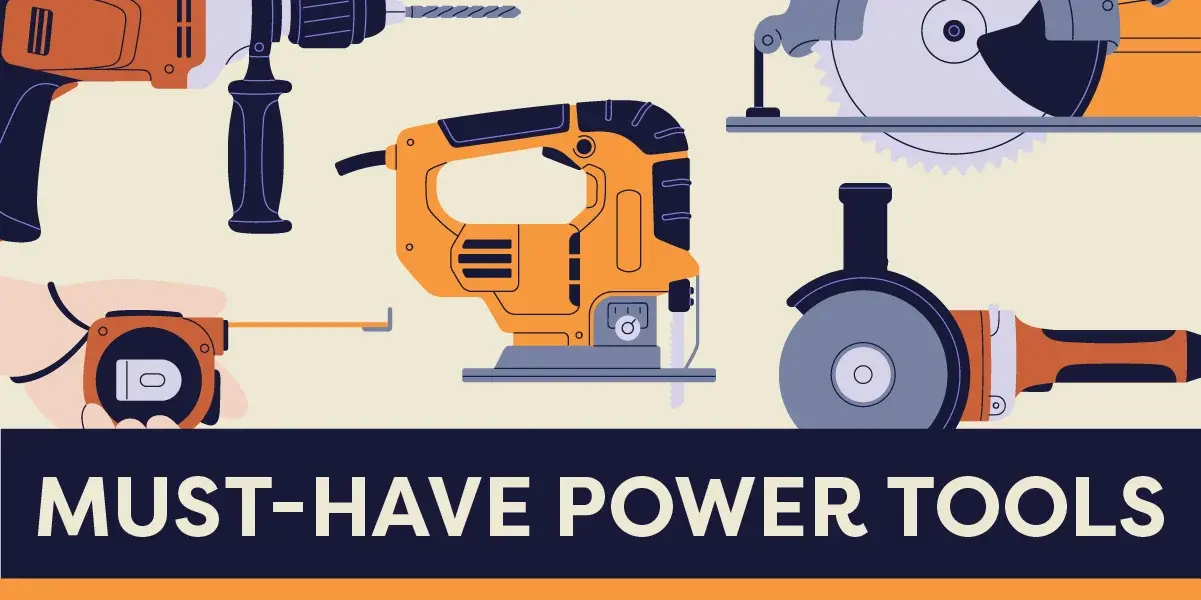Do you plan to build a deck or spruce up a newly purchased home?
Chances are, you’re already equipped with a truckload of tools for your DIY projects. But if you’re new to the DIY game or short a tool here and there, we’ve compiled a list of essential power tools for everything from home renovations to crafting bespoke furniture.
1. Cordless Drill
How many DIY projects call for drilling? Nearly all of them!
Here’s why the cordless drill is an indispensable tool, even for novice DIYers:
- Versatility: It can drill holes and drive screws into wood, metal, plastic, and masonry, making it useful for multiple projects.
- Adjustable Torque Settings: This feature reduces the risk of stripping screws and damaging the work surface.
- Variable Speeds: Most cordless drills offer control over the drilling speed, which is crucial when working with different materials.
- Power and Efficiency: Modern cordless drills have lithium-ion batteries with longer life, consistent power output, and quick recharging times.
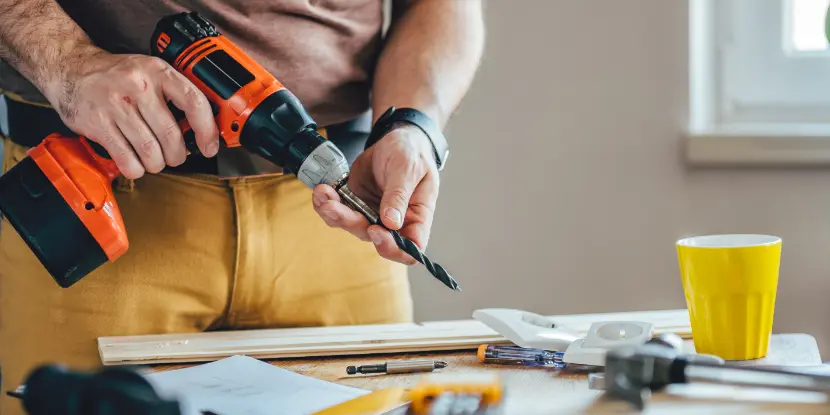
Inserting a drill bit into a cordless drill.
2. Circular Saw
Whether cutting straight lines, slicing through plywood, or trimming 2X4s, the circular saw does the job fast and efficiently.
- Precision Cutting: A circular saw produces quick, clean cuts across various materials. It can help with everything from rough construction to fine woodworking.
- Ease of Use: Its straightforward design and light weight make it a user-friendly tool for beginners.
- Multiple Blade Options: Swap the blade to suit different materials and projects.
- Portability: Cordless models give you the freedom to work almost anywhere.
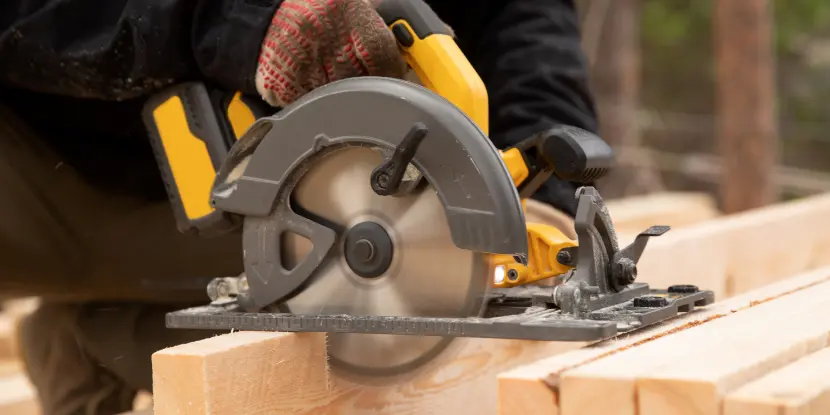
Cutting boards to length with a circular saw.
3. Jigsaw
The jigsaw makes cutting holes and curved shapes as effortless as slicing through butter.
- Curved Cuts: The jigsaw is the go-to tool for precision cutting intricate shapes and rounded edges.
- Bevel Cuts: With an adjustable base, it can easily make angled cuts.
- Versatility: Purpose-made blades enable work on different materials like wood, metal, and plastic.
- Portability: Cordless models allow maneuvering around tight spaces or working outdoors.
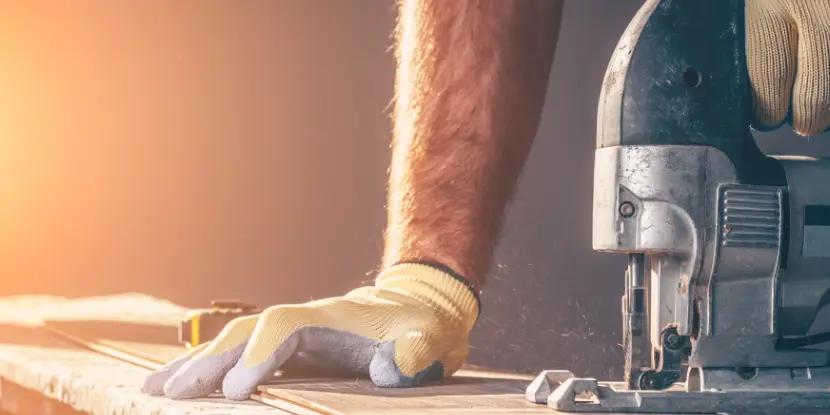
Making a curved cut in plywood with a power jigsaw.
4. Impact Driver
Impact drivers are big boys of drilling and screwing, delivering high torque for projects like building decks, installing cabinets, and more.
- High Torque Output: Impact drivers produce significantly more torque than cordless drills, making them ideal for driving large screws and fasteners.
- Less Strain on the User: Thanks to the rotational impact mechanism, users experience less wrist and hand fatigue than with a standard drill.
- Efficiency on Tough Materials: An impact driver can handle dense wood or metal that might stall or slow down a cordless drill.
- No Cam-Out Effect: An impact driver’s hexagonal chuck grips the screw tightly, reducing slippage or “cam-out” during use.
- Compact Size: Typically smaller and lighter than most drills, an impact driver can fit into tighter spaces.
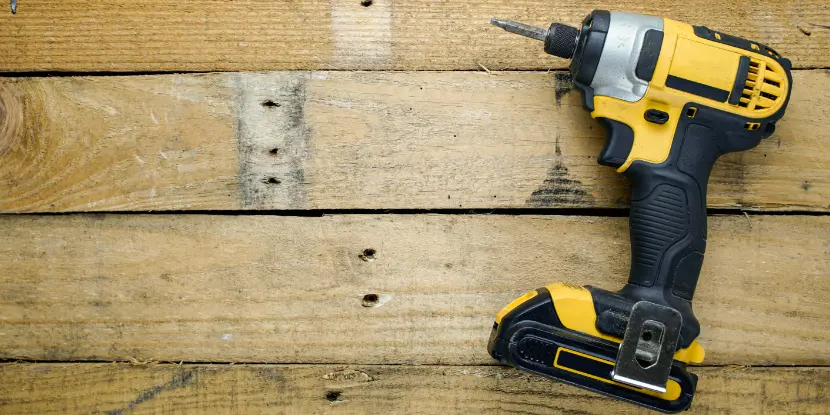
An impact driver lying on a deck.
5. Router
A router can add finishing touches that elevate your project from good to great. Here’s why it’s a must-have in your DIY toolkit:
- Edge Shaping: A router creates smooth, uniform edges, whether rounded, beveled, or any other profile, for a custom, crafted look.
- Cutting Grooves and Dadoes: It’s the go-to tool for cutting precise grooves, slots, or dadoes for joinery or inlay work, essential for cabinet making and other woodworking projects.
- Decorative Finishes: A router can add intricate details and decorative finishes to wood, enhancing the aesthetics of a project.
- Efficiency: A powerful motor and adjustable speed settings enable a router to work through different materials quickly and with control, ensuring clean, precise cuts.
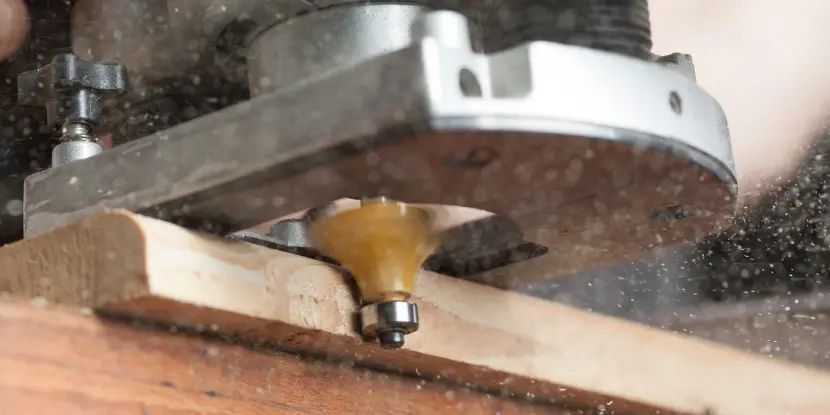
A router is the tool of choice for decorative edges.
6. Random Orbital Sander
Smoothing a surface can be the most time-consuming part of any woodworking project. That’s where the random orbital sander comes in.
- Uniform Finishing: This sander makes smooth, consistent passes without leaving circular scratches or swirl marks.
- Suitable for Different Materials: Use it to sand wood, metal, plastic, and even stone.
- Sand off Paint or Varnish: Attach the right grit sandpaper to strip paint or varnish easily.
- Dust Collection: Most models have built-in dust collection systems, which keep your work area clean and debris-free.
- Ergonomic Design: With its comfortable grip and minimal vibrations, this sander won’t tire out your hands during extended use.

Using an orbital sander to finish a door before painting.
7. Power Planer
Some finishing jobs are too big for a sander. That’s why a power planer should play a complementary role in your toolbox.
- Thickness Shaving: A power planer removes large amounts of material from the surface of wood, making it perfect for adjusting thickness and flattening boards.
- Smoothing Rough Lumber: Unlike a sander that primarily finishes surfaces, a planer can smooth out rough lumber, prepping it for finer work.
- Edge Trimming: It can also trim doors and level out uneven edges with precision that a sander can’t match.
- Speed and Efficiency: For rapid material removal and preparation of rough lumber, a power planer operates at a speed and efficiency beyond what a sander can achieve.
- Precision: With its adjustable depth settings, a power planer lets you trim wood to exact dimensions.
8. Reciprocating Saw
A reciprocating saw is a powerhouse cutting tool for tough, unglamorous jobs.
- Demolition Work: It carves through wood with nails, plasterboard, metal, plastic, and even ceramic.
- Yard Work: Its versatility extends to yard work, where it trims branches and roots with less mess and more safety than a chainsaw.
- Portability: Cordless models enable you to work anywhere, from construction sites to large backyards.
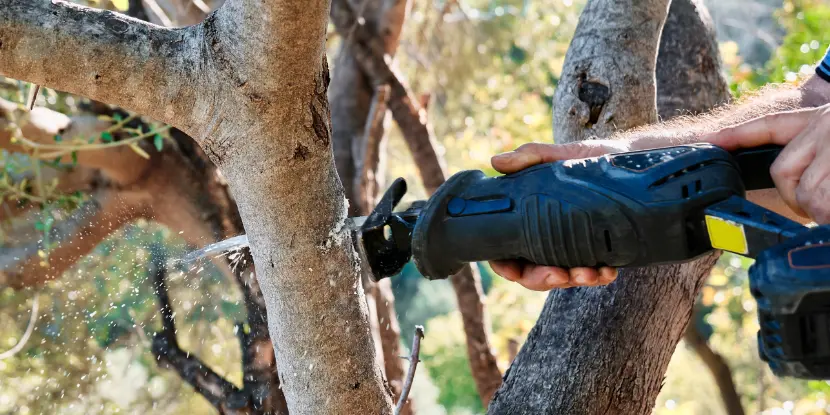
Trimming a tree with a reciprocating saw.
9. Angle Grinder
An angle grinder cuts, grinds, and polishes with unmatched efficiency. Here’s what makes it so exceptional:
- Cutting: Whether it’s slicing through metal bars, cutting off bolts, or trimming tile and concrete, an angle grinder tackles the job with precision and control.
- Grinding: It cleans up welds, smooths out surfaces, and removes rust or paint, preparing materials for finishing work.
- Polishing: With the right attachments, it can polish metal and stone to a mirror finish, showing its value beyond cutting and grinding.
- Adjustable Speed: Variable speed controls ensure optimal performance on various materials.

Using an angle grinder to cut through steel pipe.
10. Heat Gun
A heat gun applies focused heat for various purposes beyond paint stripping, the task it’s best known for.
- Paint Stripping: A heat gun softens old paint for easy, non-chemical removal.
- Bending PVC Pipes: It makes PVC pipes pliable for bending, which is critical in plumbing and construction projects.
- Removing Adhesives: It can loosen adhesives and facilitate the removal of floor coverings, labels, and stickers without residue.
- Thawing Frozen Pipes: It can safely thaw frozen pipes, preventing costly water damage.
- Shrink Wrapping: It can shrink wrap packages and gifts for a professional finish.
- Crafting and Embossing: Heat guns can melt powder to create a raised surface on paper, fabric, and other materials.

A DIYer stripping paint with a heat gun.
FAQs: Essential DIY Power Tools
Q: Are there other power tools I should consider for my workshop?
If space and budget allow, consider a miter saw for accurate cross-cutting, a table saw for larger projects, a nail gun for quick and efficient nailing, and a band saw for intricate curved cuts.
Q: Can I use power tools for detailed and intricate work?
Yes. For example, a router enables delicate edge treatments, while a jigsaw can make intricate cuts in wood and metal sheets.
Q: What safety precautions should I take when using power tools?
Read and follow the manufacturer’s instructions and safety guidelines for each tool. Wear appropriate protective gear, such as safety glasses, gloves, and earplugs. Ensure the tool is in good working condition before use, and always unplug it or remove the battery when not in use.
Q: Are cordless power tools as powerful as corded ones?
Advancements in battery technology have made cordless power tools just as powerful as their corded counterparts, with the added benefit of portability. However, they may require frequent recharging or battery replacements for extended use.
Q: Can I use one power tool for multiple tasks?
Many power tools have adjustable settings and various attachments or blades that allow them to perform multiple tasks. However, using the right tool for the job will yield better results and ensure safety.
Q: How often should I maintain my power tools?
Clean your tools after each use, check for wear or damage before and after operation, and lubricate moving parts regularly. Consult your tool’s manual for specific maintenance recommendations.
Q: What’s the best way to store power tools?
Store your tools in a clean, dry place to prevent rust and damage. Original cases or toolboxes offer additional protection. For cordless tools, remove batteries before storage.
Q: Are there environmentally friendly options for power tools?
Most manufacturers now offer eco-friendly power tools that run on lithium-ion batteries, which are more efficient and have a lower environmental impact than traditional nickel-cadmium batteries.
Q: Can I use power tools in wet conditions?
Generally, it’s unsafe to use power tools in wet conditions due to the risk of electric shock or tool damage. However, some power tools are designed to be water-resistant. Always check the manufacturer’s guidelines.
Q: What should I do if a power tool breaks during use?
Immediately stop using it and unplug it or remove its battery if it’s cordless. Don’t attempt to repair the tool yourself unless you’re qualified to do so. Read the manufacturer’s warranty for replacement or repair.
Q: How can I reduce the noise that power tools produce?
Consider using tools with noise reduction technology or operating them during hours when noise is less likely to disturb others. Install sound-dampening materials in your workspace and wear ear protection.
Q: Is it worth investing in multi-functional power tools?
Multi-tools or combination drills can offer great value and save space in your workshop. However, dedicated tools usually achieve the best results for specialized tasks.

